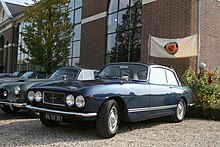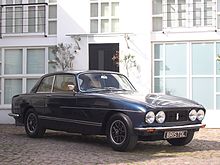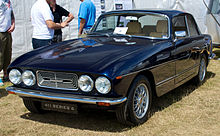Bristol 411
| Bristol | |
|---|---|
|
Bristol 411 Mk. 3
|
|
| 411 | |
| Production period: | 1969-1976 |
| Class : | Upper class |
| Body versions : | limousine |
| Engines: |
Petrol engines : 5.9–6.6 liters (194–294 kW) |
| Length: | 4902 mm |
| Width: | 1727 mm |
| Height: | 1410 mm |
| Wheelbase : | 2895 mm |
| Empty weight : | 1500 kg |
| Previous model | Bristol 410 |
| successor | Bristol 603 |
The Bristol 411 was a two-door sedan produced by the British car manufacturer Bristol Cars , which replaced the Bristol 410 in 1969 and was produced until 1976. Over the course of seven years of production, the model gradually underwent numerous technical and optical modifications. Some of these changes were so serious that, based on the manufacturer's previous practice, they actually justified a new model name; At least that was the case for the change from the 411 Mk.2 to the Mk.3 and from the Mk. 3 to the Mk.4. Nevertheless, Bristol kept the designation "411" for all variants and differentiated the individual models according to series (Mark 1 to Mark 5). The model is currently being offered again as a Series 6 Coupé by Bristol Cars.
Model history
Bristol 411 Mk. 1
The Bristol 411 Mk. 1 was introduced in the spring of 1969. The main difference to the previous 410 was the use of a much larger motor. Bristol parted with the tried and tested 5.2 liter eight-cylinder after eight years and now relied on a 6.3 liter engine from Chrysler , which had been used in a similar configuration for a long time in the Jensen Interceptor . The new engine was less heavily processed than the previous engine; Bristol from now on essentially used stock engines. The adaptation of the new engine to the car resulted in numerous technical detail changes. According to Bristol, the reason for changing the engine was primarily the fact that the new engine was more service-friendly, as it was no longer necessary to adjust the valve clearance. It should be noted, however, that the larger engine was associated with a significant increase in performance. The engine now delivered 335 SAE horsepower.
The bodywork had also been redesigned in numerous details. The changes were so subtle that they were barely noticeable at first glance. The most noticeable modifications concerned the side trim strip - only one instead of the previous two - as well as the rear section: The indicated rear wing was now dispensed with, while the Humber rear lights were basically retained ; the rear of the car was instead smooth. Apart from that, Bristol had redesigned the shape of the radiator grille, modified the location of the auxiliary headlights and revised the curves of the front fenders. The use of a new steering wheel in the interior was noticeable: instead of the traditional two-spoke steering wheel from Bluemel, a three-spoke model was installed with a Bristol coat of arms in the hub.
The performance increased significantly with the new engine. The top speed of the Bristol 411 was 230 km / h, for the acceleration from 0 to 60 mph, the factory gave a value of 7 seconds. According to Autosport magazine, the Bristol 411 Mk. 1 was the fastest production touring car in the world.
When it was first launched, the Bristol 411 was priced at £ 6,997.
Bristol 411 Mk. 2
In the autumn of 1970 Bristol presented a first revised version of the 411. From a technical point of view, the main innovation was the use of an automatic - instead of previously manual - level control. Outwardly, there were some very subtle changes that were to be understood as cosmetic modifications. Bristol used new door handles and locks that were slimmer. The Mk. 2 was produced until 1972.
Bristol 411 Mk. 3
With the introduction of the third series in July 1972, the Bristol 411 received a largely new body. The basic layout of the car and the design of the passenger cell remained essentially unchanged, but apart from that, the front and rear sections were redesigned in a striking way. The radiator grille now ran across the entire width of the vehicle. Integrated into it were four large round headlights from the supplier Lucas, whose diameter was almost 20 centimeters and which ensured excellent visibility when driving at night. Between the headlights was a chrome-plated radiator grille, which, due to its shape, was reminiscent of a toaster. The element was then called toaster grill or barbecue grill in the press . It was retained in all subsequent 411 models and was also found - in a modified form - in the Bristol 412 and later in the Bristol Britannia and the Bristol Brigand, but not in the immediate successor to the 411, the Bristol 603 . Corresponding to the new front section, the bonnet and the front fenders had also been redesigned. The latter were slightly raised to improve the visibility of the front end. At the rear, the old taillights of the Humber Scepter were replaced by new, rectangular taillights that were still vertical. Reversing lights were on both sides next to the license plate. Overall, the 411 Mk. 3 made a much more contemporary impression than its predecessor, without being really fashionable or modern itself.
A special feature were two double exhaust pipes that protruded noticeably from under the rear end plate of the car. These were dummies. In fact, the exhaust gas exited through a downward opening about two inches from the end of the exhaust pipes. This construction was intended to ensure that escaping exhaust gases did not leave any traces on the Bristol driver's garage wall. The interior was classic. The style, the ergonomics and the good workmanship were unanimously praised in the press; only the use of British Leyland door handles has been the subject of criticism.
The drive technology was only slightly modified. The 6.3 liter Chrysler engine was retained, but Bristol reduced the compression ratio to 9.5: 1 in terms of emissions and fuel consumption (instead of 10.1: 1 as before). This was associated with a reduction in engine performance and also in driving performance.
Bristol 411 Mk. 4
A newly revised model appeared as early as autumn 1973, the 411 Mk. 4. This time the changes were mainly of a technical nature. Bristol wanted to react to the slightly deteriorated performance that had resulted from the modifications to the Mk. 3. In order to ensure the well-known sportiness again, the company management decided - as was the case with Jensen - to use a new, even larger engine. However, the decision was not made for the 7.2 liter engine from Chrysler , which caused numerous thermal problems at Jensen. A 411 is said to have been equipped with this engine for test purposes; In the end, however, the choice fell on the smaller, lighter and similarly powerful 6.6 liter engine from Chrysler. With a compression of only 8.2: 1, which enabled the use of normal gasoline, the result was an output of 264 hp according to European measurement methods. The Mk. 4 thus achieved performance levels that were back on the level of the 411 Mk. 2. The same engine was used on the Bristol 412 unveiled in 1974 , a safety convertible with a body made by Zagato .
The Bristol 411 Mk. 4 was priced at £ 8,973 when it was first launched.
Bristol 411 Mk. 5
In the summer of 1975 the last expansion stage of the Bristol 411 was presented. The changes were purely cosmetic. The toaster grill was now painted black. Some emblems changed and the car was fitted with automatic retractor seat belts as standard.
A special feature were the optionally available Avon safety tires, which made it possible to check the car even in the event of a defect at high speeds. The owner of Bristol Cars, Tony Crook, demonstrated this to representatives of the media during a test drive at an airfield by accelerating a Bristol 411 (albeit a converted Mk. 4) to 230 km / h and then using a technical device a front tire burst. Apart from a slight lurch after the explosion, the car continued on its correct course.
The purchase price for a new car in 1975 was £ 12,587.
The Bristol 411 Mk. 5 was the last Bristol model whose body was conceptually based on the now 15-year-old Bristol 406 . It was replaced in the fall of 1976 by the Bristol 603 , which received a completely new, independent design.
Bristol 411 Series 6
The factory-set Bristol 411 Series 6 model occupies a special position . The automobiles of this generation are not new, but extensively restored vehicles from earlier series. The first Bristol 411 Series 6 was completed in 2008. Other eight-cylinder models were later converted in this way by Bristol. The vehicles were delivered with a new vehicle guarantee.
As part of the restoration, the customers' used vehicles are completely dismantled and rebuilt using numerous new parts. The chassis of the donor vehicle is also the basis of the newly built vehicle. While the body design remains unchanged, the technical components are largely replaced. The vehicles receive the drive and chassis technology of the current Bristol Blenheim 3 , so that the performance, the driving behavior and the emissions are significantly improved. The vehicles will be equipped with the current 5.9 liter eight-cylinder engine; Depending on the customer's requirements, the standard version or the heavily processed version from the Blenheim 3S can be used, which, according to the factory specifications, has an output of up to 400 hp. The Blenheim's computer-controlled four-speed automatic is also adopted. Finally, the vehicles are equipped with a modern audio system, satellite navigation system and an iPod connection.
Importance of the 411 for the company
The 411 was an important car for Bristol Cars. With this model, the company managed to weather the difficult period of the first oil crisis , which was also a difficult phase for manufacturers of expensive luxury vehicles. While numerous suppliers of similarly designed cars such as Iso Rivolta or Jensen failed due to the oil crisis and even Aston Martin went bankrupt, Bristol stayed on the market over the years. In addition to the convincing, changeable basic concept of the 411, the main reason for this was the fact that Bristol kept the model attractive through continuous modifications and regularly gave customers incentives to order new cars. In addition, the company managed to work cost-effectively even with low production numbers; in this way - unlike the competition - overcapacities could be avoided. It is noteworthy that during this problematic phase, Bristol even managed to develop a sister model, the Bristol 412 , which was introduced in 1974 , which further intensified interest in the brand.
literature
- RM Clarke: Bristol Cars: A Brooklands Portfolio: 132 Contemporary Articles Drawn from International Motoring Journals , UK 2001 (engl.)
- Fastest true four-seater touring car . Presentation of the Bristol 411 Mk. 1 in: Autosport , August 20, 1970
- British as boiled beef, brand profile and presentation of the Bristol 411 Mk. 3 in: Wheels , February 1973.
- Idiot . Driving report Bristol 411 Mk. III in: Motor Klassik 10/2000, p. 24 ff.
Web links
- Bristol Type 411 The Bristol Owners Club describes the series.
- Sales brochure of a Bristol 411 Mk. 2 from 1969.
- Images of the Bristol 411 Series 6 at www.classicandperformancecar.com , accessed November 18, 2010.
Individual evidence
- ↑ The first Bristol 411 Series 6 is shown in a sales brochure from summer 2009 next to the current Blenheim Mk. 3.
- ↑ AutoTrader Classics for Series 6
- ↑ For the scope of the processing s. Internet presence of Bristol Cars ("Series 6") ( Memento of the original from February 11, 2011 in the Internet Archive ) Info: The archive link was inserted automatically and has not yet been checked. Please check the original and archive link according to the instructions and then remove this notice. , accessed November 18, 2010.
| Vehicle class | Body versions | 1940s | 1950s | 1960s | 1970s | 1980s | 1990s | 2000s | 2010s | 2020s | ||||||||||||||||||||||||||||||||||||||||||||||||||||||||||||||||||
| 6th | 7th | 8th | 9 | 0 | 1 | 2 | 3 | 4th | 5 | 6th | 7th | 8th | 9 | 0 | 1 | 2 | 3 | 4th | 5 | 6th | 7th | 8th | 9 | 0 | 1 | 2 | 3 | 4th | 5 | 6th | 7th | 8th | 9 | 0 | 1 | 2 | 3 | 4th | 5 | 6th | 7th | 8th | 9 | 0 | 1 | 2 | 3 | 4th | 5 | 6th | 7th | 8th | 9 | 0 | 1 | 2 | 3 | 4th | 5 | 6th | 7th | 8th | 9 | 0 | 1 | 2 | 3 | 4th | 5 | 6th | 7th | 8th | 9 | 0 | ||
| Upper class | limousine | 405 | ||||||||||||||||||||||||||||||||||||||||||||||||||||||||||||||||||||||||||
| Coupé / convertible | 400 | 403 | ||||||||||||||||||||||||||||||||||||||||||||||||||||||||||||||||||||||||||
| 401 | 405 | 406 | 407 | 408 | 409 | 410 | 411 | 603 | Brigand | Blenheim | ||||||||||||||||||||||||||||||||||||||||||||||||||||||||||||||||||
| 402 | Britannia | |||||||||||||||||||||||||||||||||||||||||||||||||||||||||||||||||||||||||||
| Sports car | Coupé / convertible / roadster | 404 | 406 Zagato | 412 | Beaufighter | Blenheim Speedster | Bullet | |||||||||||||||||||||||||||||||||||||||||||||||||||||||||||||||||||||
| Arnolt-Bristol | Fighter | |||||||||||||||||||||||||||||||||||||||||||||||||||||||||||||||||||||||||||
| race car | - | 450 | ||||||||||||||||||||||||||||||||||||||||||||||||||||||||||||||||||||||||||






